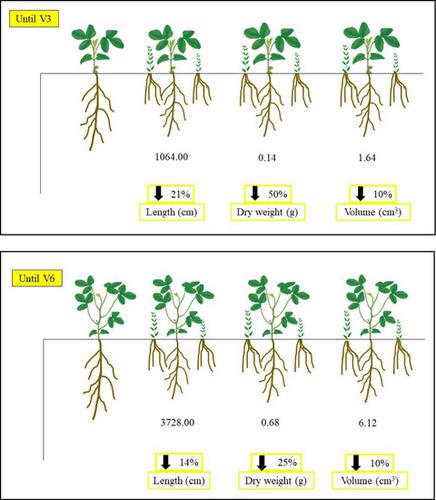当前位置:
X-MOL 学术
›
Plant Biol.
›
论文详情
Our official English website, www.x-mol.net, welcomes your feedback! (Note: you will need to create a separate account there.)
Competition at the soybean V6 stage affects root morphology and biochemical composition.
Plant Biology ( IF 3.9 ) Pub Date : 2019-12-17 , DOI: 10.1111/plb.13070 A P Rockenbach 1 , M A Rizzardi 1
Plant Biology ( IF 3.9 ) Pub Date : 2019-12-17 , DOI: 10.1111/plb.13070 A P Rockenbach 1 , M A Rizzardi 1
Affiliation

|
The experiment was conducted in the 2016/17 crop season in a greenhouse at Passo Fundo University, Brazil. We hypothesised that the morphological characteristics and biochemical and anatomical composition of soybean roots and shoots, when competing with weeds during different growth periods, are negatively affected, so current concepts of competition between plants should also consider changes in plant roots. The soybean cultivar P 95R51 and horseweed (Conyza bonariensis) were used. The treatments consisted of the presence or absence of weeds during different coexistence periods of soybean with horseweed. The periods were V0-V3, V0-V6, V0-R2, V3-R6, V6-R6 and R2-R6, where V0 was the date of soybean sowing and V3, V6, R2 and R6 were phenological stages of the crop. Two fresh roots were used to examine morphological traits. Four roots were used for quantification of dry matter and secondary metabolites. Root length was reduced by 21%, 14% and 20% when competing with a weed in the V0-V3, V0-V6 and R2-R6 coexistence periods, respectively. Total phenol content in the V0-V6 and V0-R2 periods was reduced when plants were in competition with weeds; a similar trend was found for flavonoids in the V0-V6 period. Soybean-horseweed competition from crop emergence to the V6 stage, in general, affects shoot and root morphological traits and the biochemical composition of the soybean roots. The presence of horseweed at the V3, V6 and R2 stages does not negatively alter the traits evaluated. Root anatomical composition is not modified during all coexistence periods with horseweed.
中文翻译:

大豆V6阶段的竞争影响根系形态和生化组成。
该实验是在2016/17作物季节在巴西Passo Fundo大学的温室中进行的。我们假设大豆根和芽的形态特征,生化和解剖学组成在不同生长期与杂草竞争时受到负面影响,因此当前植物间竞争的概念也应考虑植物根的变化。使用大豆品种P 95R51和马草(Conyza bonariensis)。处理包括在大豆与马草的不同共存期间存在或不存在杂草。期间为V0-V3,V0-V6,V0-R2,V3-R6,V6-R6和R2-R6,其中V0为大豆播种日期,而V3,V6,R2和R6为作物的物候期。用两个新鲜的根检查形态特征。四个根用于定量干物质和次生代谢产物。在V0-V3,V0-V6和R2-R6共存时期与杂草竞争时,根长分别减少了21%,14%和20%。当植物与杂草竞争时,V0-V6和V0-R2时期的总酚含量降低了。在V0至V6期间发现了类黄酮的类似趋势。从作物出苗到V6阶段的大豆-马草竞争通常会影响大豆的根和茎形态特征以及其根的生化组成。在V3,V6和R2阶段存在马草不会负面影响所评估的性状。根部解剖成分在与马草的所有共存期间均未改变。在V0-V3,V0-V6和R2-R6共存期间与杂草竞争时分别达到14%和20%。当植物与杂草竞争时,V0-V6和V0-R2时期的总酚含量降低了。在V0至V6期间发现了类黄酮的类似趋势。从作物出苗到V6阶段的大豆-马草竞争通常会影响大豆的根和茎形态特征以及其根的生化组成。在V3,V6和R2阶段存在马草不会负面影响所评估的性状。根部解剖成分在与马草的所有共存期间均未改变。在V0-V3,V0-V6和R2-R6共存期间与杂草竞争时分别达到14%和20%。当植物与杂草竞争时,V0-V6和V0-R2时期的总酚含量降低了。在V0至V6期间发现了类黄酮的类似趋势。从作物出苗到V6阶段的大豆-马草竞争通常会影响大豆根部的茎和根形态特征以及生化成分。在V3,V6和R2阶段存在马草不会负面影响所评估的性状。根部解剖成分在与马草的所有共存期间均未改变。在V0至V6期间发现了类黄酮的类似趋势。从作物出苗到V6阶段的大豆-马草竞争通常会影响大豆的根和茎形态特征以及其根的生化组成。在V3,V6和R2阶段存在马草不会负面影响所评估的性状。根部解剖成分在与马草的所有共存期间均未改变。在V0至V6期间发现了类黄酮的类似趋势。从作物出苗到V6阶段的大豆-马草竞争通常会影响大豆根部的茎和根形态特征以及生化成分。在V3,V6和R2阶段存在马草不会负面影响所评估的性状。根部解剖成分在与马草的所有共存期间均未改变。
更新日期:2019-12-17
中文翻译:

大豆V6阶段的竞争影响根系形态和生化组成。
该实验是在2016/17作物季节在巴西Passo Fundo大学的温室中进行的。我们假设大豆根和芽的形态特征,生化和解剖学组成在不同生长期与杂草竞争时受到负面影响,因此当前植物间竞争的概念也应考虑植物根的变化。使用大豆品种P 95R51和马草(Conyza bonariensis)。处理包括在大豆与马草的不同共存期间存在或不存在杂草。期间为V0-V3,V0-V6,V0-R2,V3-R6,V6-R6和R2-R6,其中V0为大豆播种日期,而V3,V6,R2和R6为作物的物候期。用两个新鲜的根检查形态特征。四个根用于定量干物质和次生代谢产物。在V0-V3,V0-V6和R2-R6共存时期与杂草竞争时,根长分别减少了21%,14%和20%。当植物与杂草竞争时,V0-V6和V0-R2时期的总酚含量降低了。在V0至V6期间发现了类黄酮的类似趋势。从作物出苗到V6阶段的大豆-马草竞争通常会影响大豆的根和茎形态特征以及其根的生化组成。在V3,V6和R2阶段存在马草不会负面影响所评估的性状。根部解剖成分在与马草的所有共存期间均未改变。在V0-V3,V0-V6和R2-R6共存期间与杂草竞争时分别达到14%和20%。当植物与杂草竞争时,V0-V6和V0-R2时期的总酚含量降低了。在V0至V6期间发现了类黄酮的类似趋势。从作物出苗到V6阶段的大豆-马草竞争通常会影响大豆的根和茎形态特征以及其根的生化组成。在V3,V6和R2阶段存在马草不会负面影响所评估的性状。根部解剖成分在与马草的所有共存期间均未改变。在V0-V3,V0-V6和R2-R6共存期间与杂草竞争时分别达到14%和20%。当植物与杂草竞争时,V0-V6和V0-R2时期的总酚含量降低了。在V0至V6期间发现了类黄酮的类似趋势。从作物出苗到V6阶段的大豆-马草竞争通常会影响大豆根部的茎和根形态特征以及生化成分。在V3,V6和R2阶段存在马草不会负面影响所评估的性状。根部解剖成分在与马草的所有共存期间均未改变。在V0至V6期间发现了类黄酮的类似趋势。从作物出苗到V6阶段的大豆-马草竞争通常会影响大豆的根和茎形态特征以及其根的生化组成。在V3,V6和R2阶段存在马草不会负面影响所评估的性状。根部解剖成分在与马草的所有共存期间均未改变。在V0至V6期间发现了类黄酮的类似趋势。从作物出苗到V6阶段的大豆-马草竞争通常会影响大豆根部的茎和根形态特征以及生化成分。在V3,V6和R2阶段存在马草不会负面影响所评估的性状。根部解剖成分在与马草的所有共存期间均未改变。


























 京公网安备 11010802027423号
京公网安备 11010802027423号